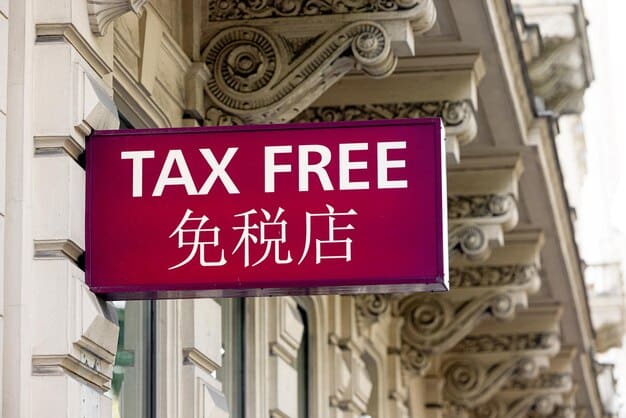Duty-Free Shopping in Japan: US Traveler’s Guide (2025 Tax Refund)

Duty-free shopping in Japan offers US travelers a chance to save 10% on purchases by claiming a tax refund at the airport in 2025, provided they meet eligibility requirements and follow specific procedures.
Planning a trip to Japan in 2025? Enhance your shopping experience by understanding how to make the most of duty-free shopping in Japan: A US Traveler’s Guide to Claiming Your 10% Tax Refund at Airports in 2025. This guide explains how to save money on your purchases.
Understanding Duty-Free Shopping in Japan
Duty-free shopping in Japan allows tourists, including those from the US, to purchase goods without paying consumption tax. Understanding the basics is crucial to take advantage of this system.
What is Duty-Free?
Duty-free refers to purchasing items without the inclusion of certain taxes and duties. In Japan, this primarily concerns the 10% consumption tax.
For US travelers, this offers a significant opportunity to save money on goods purchased during their trip.
Eligibility for Duty-Free Shopping
- Residency: Only non-residents, such as tourists, are eligible for duty-free shopping.
- Duration of Stay: You must be staying in Japan for no more than six months.
- Purpose of Purchase: Goods must be for personal use and taken out of Japan.

Types of Goods Eligible for Tax Refund
Knowing which products qualify for tax refunds can help you plan your shopping effectively.
- General Goods: These include clothing, accessories, electronics, and crafts.
- Consumables: This category covers food, beverages, cosmetics, and medicines.
- Minimum Purchase Amount: There are minimum spending requirements per day per store to qualify for the tax refund. For general goods and consumables, the minimum is typically 5,000 yen (approximately $35 USD as of 2025, but verify exchange rates).
To summarize, duty-free shopping in Japan is a fantastic way for US travelers to save money, but it requires understanding eligibility and purchase conditions.
Finding Duty-Free Stores in Japan
Knowing where to shop is key to maximizing your duty-free benefits. Japan offers numerous options for tax-free shopping.
Department Stores
Major department stores like Mitsukoshi, Isetan, and Takashimaya offer a wide range of products eligible for duty-free. They often have dedicated tax refund counters.
Shopping in department stores provides a convenient and reliable duty-free experience.
Electronics Retailers
Stores like Bic Camera and Yodobashi Camera are popular for electronics and appliances. These retailers also offer duty-free shopping to tourists.
- Variety: Wide selection of electronics and appliances.
- Tax Refund Services: Dedicated counters for processing tax refunds.
- Convenience: Located near major train stations and tourist areas.
Drugstores
For cosmetics, medicines, and health products, drugstores like Matsumoto Kiyoshi and Sun Drug provide duty-free options.
Drugstores are excellent for stocking up on consumables while enjoying tax savings.

Specialty Shops and Boutiques
Many smaller boutiques and specialty shops also offer duty-free shopping. Look for the “Tax-Free” shopping logo.
- Unique Items: Discover local crafts, fashion, and souvenirs.
- Personalized Service: Enjoy a more intimate shopping experience.
- Support Local Businesses: Contribute to the local economy.
Ultimately, locating duty-free stores in Japan is straightforward, with options ranging from large department stores to local boutiques.
The Step-by-Step Tax Refund Process at Japanese Airports
Claiming your 10% tax refund at Japanese airports requires following a specific procedure. Being prepared will ensure a smooth experience.
Collect Your Purchase Records
Keep all purchase records (receipts) and the Record of Purchase (a form attached to your passport at the time of purchase) in a safe place. Do not remove these items from your passport. Failing to do so could lead to issues when trying to claim your tax refund.
Maintaining organized records is vital for a hassle-free refund process.
At the Airport: Customs Check
Before going through security, visit the customs counter. Present your passport, purchase records, and purchased items to the customs officer.
The customs check ensures that you are taking the purchased items out of the country.
Verification and Confirmation
The customs officer will verify your documents and may ask to inspect your purchased items. Ensure you have the items accessible for inspection.
- Passport: Required for identification and eligibility verification.
- Purchase Records: Necessary to validate the amount of tax refund.
- Purchased Items: Must be available for inspection.
Submitting the Record of Purchase
After verification, the customs officer will remove the Record of Purchase from your passport. This document confirms that you have completed the duty-free process.
This signifies the end of the tax refund process at the airport.
In conclusion, claiming your tax refund at a Japanese airport involves methodical steps from collecting your records to customs verification, ensuring you receive your 10% refund efficiently.
Common Mistakes to Avoid When Duty-Free Shopping
To ensure a smooth duty-free shopping experience, familiarize yourself with common pitfalls to avoid problems.
Exceeding the Spending Limit
Ensure each purchase meets the minimum spending limit per store per day to qualify for the tax refund. Typically, this is 5,000 yen but verify the exact amount with the retailer.
- Track Spending: Keep a record of your purchases.
- Combine Purchases: If a single item doesn’t meet the minimum, consider buying additional items from the same store.
- Verify Limits: Confirm the exact limit with each store.
Consuming Consumables in Japan
Consumables (food, drinks, cosmetics, etc.) should not be consumed while in Japan. They must be taken out of the country.
Consuming these items can lead to issues at customs and invalidate your tax refund.
For Example: A US traveler who purchases snacks and alcohol duty-free but consumes them during their stay will violate the rules.
Removing Tags and Packaging
Do not remove tags, packaging, or labels from the purchased items. Keep them in their original condition for inspection at the airport.
Removing these can raise suspicions and complicate the customs process.
Be careful to present the items as they were when purchased to avoid problems.
Missing Documentation
Always keep all your purchase records, receipts, and passport readily available. Missing documents can cause delays or rejection of your tax refund.
Organize your documents in a safe and accessible place to present them when required.
By being aware of these common mistakes, US travelers can enjoy a seamless and beneficial duty-free shopping experience in Japan.
Tips for a Smooth Duty-Free Experience in Japan
To maximize your savings and ensure a stress-free duty-free shopping experience in Japan, implement these practical tips.
Plan Your Shopping
Research which stores offer duty-free options and plan your purchases accordingly. Focus on items you genuinely want and need.
Planning helps avoid impulse buys and ensures you meet the minimum spending requirements.
Shop Early
Shop early in your trip so you have ample time to collect all necessary documentation and receipts.
- Avoid Last-Minute Rush: Prevents stress and missed opportunities.
- Document Collection: Ensures time to gather all records.
- Availability: Increases chances of finding desired items.
Keep Receipts Organized
Maintain a separate folder or envelope for all your receipts and Records of Purchase. Organize them by store to quickly locate them at the airport.
Organized receipts simplify the verification process and save time at customs.
Arrive Early at the Airport
Arrive at the airport with plenty of time to spare. This allows for unexpected delays or long lines at the customs counter.
Extra time reduces stress and ensures you don’t miss your flight.
By following these tips, US travelers can enhance their duty-free shopping experience, making it more efficient and enjoyable.
Future Trends in Duty-Free Shopping (2025 and Beyond)
The landscape of duty-free shopping is constantly evolving. Staying informed about future trends will help you maximize your benefits.
Digitalization of Tax Refunds
Expect more stores to adopt digital tax refund processes. This could involve using mobile apps to scan receipts and receive refunds directly to your bank account.
- Convenience: Streamlines the tax refund process.
- Efficiency: Reduces paperwork and waiting times.
- Accessibility: Provides real-time updates on your refund status.
Enhanced Customer Service
Retailers are focusing on improving customer service for duty-free shoppers, with multilingual staff and dedicated concierge services.
Improved service enhances the overall shopping experience.
Sustainable Practices
More duty-free shops are adopting eco-friendly practices, such as using sustainable packaging and promoting environmentally friendly products.
This trend aligns with the growing global emphasis on sustainability.
Personalized Shopping Experiences
Retailers are leveraging data to offer personalized shopping recommendations and promotions to duty-free shoppers.
Personalization enhances customer satisfaction and drives sales.
Keeping an eye on these trends will enable US travelers to take full advantage of duty-free shopping in Japan.
| Key Point | Brief Description |
|---|---|
| ✅ Eligibility | Non-residents staying under six months qualify. |
| 🛍️ Eligible Goods | General and consumable goods apply with minimum spending. |
| 🛂 Airport Process | Present documents, items at customs for verification. |
| ⚠️ Common Mistakes | Avoid consuming goods and keep tags intact. |
Frequently Asked Questions
▼
Non-residents, including tourists, who stay in Japan for less than six months are eligible for duty-free shopping. The goods must be intended for personal use and taken out of the country.
▼
General goods like clothing and electronics, and consumables like food and cosmetics, qualify. Minimum purchase amounts apply, usually around 5,000 yen per store per day.
▼
Duty-free stores can be found in major department stores, electronics retailers, drugstores, specialty shops, and airports. Look for the “Tax-Free” shopping logo.
▼
You need your passport, purchase records (receipts), and the Record of Purchase (the form attached to your passport during the purchase). The goods must be available for inspection.
▼
Avoid exceeding spending limits, consuming consumables in Japan, removing tags, and missing documentation. Ensure you keep all items in their original condition.
Conclusion
Duty-free shopping in Japan provides US travelers with a valuable opportunity to save money on their purchases. By understanding the eligibility requirements, following the proper procedures, and avoiding common mistakes, you can make the most of your shopping experience and enjoy the 10% tax refund. Happy shopping!





